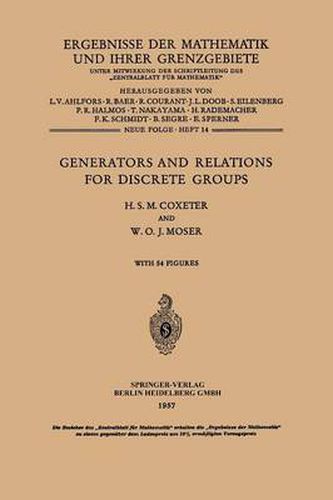Readings Newsletter
Become a Readings Member to make your shopping experience even easier.
Sign in or sign up for free!
You’re not far away from qualifying for FREE standard shipping within Australia
You’ve qualified for FREE standard shipping within Australia
The cart is loading…






This title is printed to order. This book may have been self-published. If so, we cannot guarantee the quality of the content. In the main most books will have gone through the editing process however some may not. We therefore suggest that you be aware of this before ordering this book. If in doubt check either the author or publisher’s details as we are unable to accept any returns unless they are faulty. Please contact us if you have any questions.
When we began to consider the scope of this book, we envisaged a catalogue supplying at least one abstract definition for any finitely generated group that the reader might propose. But we soon realized that more or less arbitrary restrictions are necessary, because interesting groups are so numerous. For permutation groups of degree 8 or less (i. e., subgroups of e ), the reader cannot do better than consult the 8 tables of JosEPHINE BuRNS (1915), while keeping an eye open for misprints. Our own tables (on pages 134-143) deal with groups of low order, finiteandinfinite groups of congruent transformations, symmetric and alternating groups, linear fractional groups, and groups generated by reflections in real Euclidean space of any number of dimensions. The best substitute foramoreextensive catalogue is the description (in Chapter 2) of a method whereby the reader can easily work out his own abstract definition for almost any given finite group. This method is sufficiently mechanical for the use of an electronic computer. There is also a topological method (Chapter 3), suitable not only for groups of low order but also for some infinite groups. This involves choosing a set of generators, constructing a certain graph (the Cayley diagram or DEHNsehe Gruppenbild), and embedding the graph into a surface. Cases in which the surface is a sphere or a plane are described in Chapter 4, where we obtain algebraically, and verify topologically, an abstract definition for each of the 17 space groups of two-dimensional crystallography.
$9.00 standard shipping within Australia
FREE standard shipping within Australia for orders over $100.00
Express & International shipping calculated at checkout
This title is printed to order. This book may have been self-published. If so, we cannot guarantee the quality of the content. In the main most books will have gone through the editing process however some may not. We therefore suggest that you be aware of this before ordering this book. If in doubt check either the author or publisher’s details as we are unable to accept any returns unless they are faulty. Please contact us if you have any questions.
When we began to consider the scope of this book, we envisaged a catalogue supplying at least one abstract definition for any finitely generated group that the reader might propose. But we soon realized that more or less arbitrary restrictions are necessary, because interesting groups are so numerous. For permutation groups of degree 8 or less (i. e., subgroups of e ), the reader cannot do better than consult the 8 tables of JosEPHINE BuRNS (1915), while keeping an eye open for misprints. Our own tables (on pages 134-143) deal with groups of low order, finiteandinfinite groups of congruent transformations, symmetric and alternating groups, linear fractional groups, and groups generated by reflections in real Euclidean space of any number of dimensions. The best substitute foramoreextensive catalogue is the description (in Chapter 2) of a method whereby the reader can easily work out his own abstract definition for almost any given finite group. This method is sufficiently mechanical for the use of an electronic computer. There is also a topological method (Chapter 3), suitable not only for groups of low order but also for some infinite groups. This involves choosing a set of generators, constructing a certain graph (the Cayley diagram or DEHNsehe Gruppenbild), and embedding the graph into a surface. Cases in which the surface is a sphere or a plane are described in Chapter 4, where we obtain algebraically, and verify topologically, an abstract definition for each of the 17 space groups of two-dimensional crystallography.